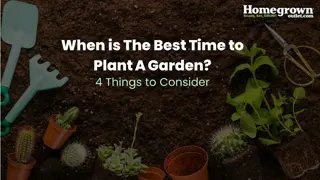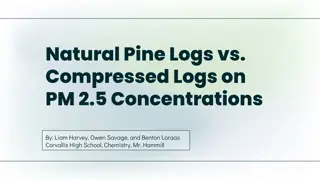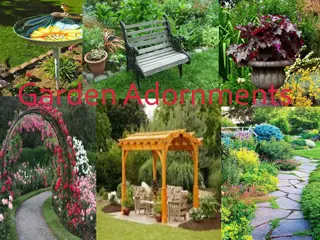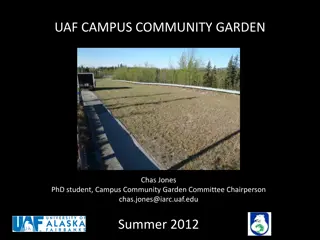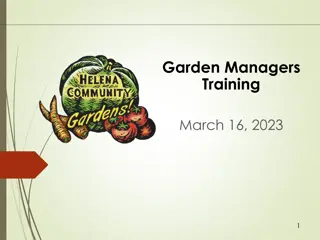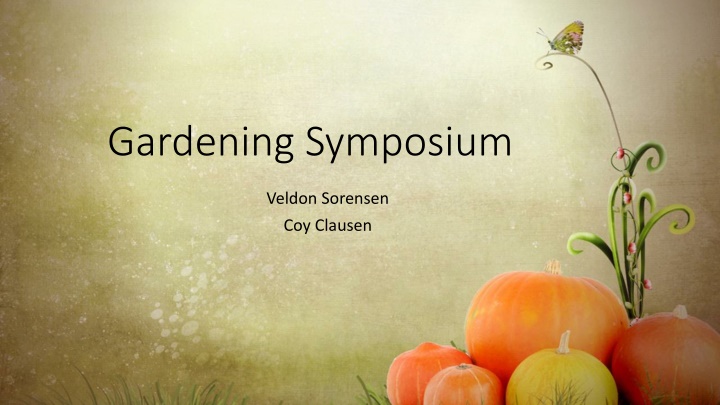
Gardening Symposium Tips and Tricks for Successful Gardening
Learn valuable tips and techniques for successful gardening, including selecting the right garden site, using fertilizers effectively, composting, raised planting beds, and choosing what to grow. Discover how to enhance plant health, reduce weed competition, and maximize your gardening efforts.
Download Presentation

Please find below an Image/Link to download the presentation.
The content on the website is provided AS IS for your information and personal use only. It may not be sold, licensed, or shared on other websites without obtaining consent from the author. If you encounter any issues during the download, it is possible that the publisher has removed the file from their server.
You are allowed to download the files provided on this website for personal or commercial use, subject to the condition that they are used lawfully. All files are the property of their respective owners.
The content on the website is provided AS IS for your information and personal use only. It may not be sold, licensed, or shared on other websites without obtaining consent from the author.
E N D
Presentation Transcript
Gardening Symposium Veldon Sorensen Coy Clausen
Rules No stupid questions I don t know all the answers Experience is a great teacher There are lots of ways to be successful
Choose a garden site Need 6-8 hours of sun Need a water source easer access the better Good drainage Easy application Can be seen from window Select the size carefully What do you like to eat? Size depends on what you can care for in 15 minutes
Choose a garden site Can grow plants just about anywhere Use lawn clippings and/or compost to improve area Fertilizers NPK buy at most garden locations (12-12-12) N nitrogen (green and above ground, usually the limiting nutrient) P Phosphorus seedling, root development K Potassium Metabolism, photosynthesis, water use Organics N - Manure, bone meal P - rock phosphate, bone meal K kelp meal
Composting Adds valuable organic material to the soil Improves soil moisture retention Improved plant health Reduces weed competition It can be: plant debris (leaves, kitchen scrapes, manure, grass clippings (unless sprayed) Good use for grass clipping, leaves, other organics Layer organic, soil, add fertilizer for speed, water regularly
Raised Planting Beds More growth in small spaces, intensive More expensive and set up time; some maintenance; Usually fewer weeds, easier access, positive aesthetics Heats up faster in spring, better drainage Use rot resistant wood, plastic lined Often uses more water
Choose a garden site When to fertilize Before planting small amounts in each transplant hole or band for seeded plants Foliar feeding is useful, but have to be consistent Side dress if needed, but most will forget
How to select what you grow Is it easy? Will I eat the produce? Will it grow here? Transplants or seeds? How much do I need to make it worth my time? Keep perennials and annuals in different areas
Cool & Warm Season Crops - Cool Germinate at 55-60F (Mid-April) Carrots Leaf lettuce Spinach Peas (get rhizobium bacteria treated seed if possible) Radishes Beets Swiss chard Cole crops (broccoli, cabbage, cauliflower)
Cool & Warm Season Crops - Warm Average last frost free day May 21/31 Beans bush and pole (get rhizobium bacteria treated seed if possible) Blue Lake, Top Crop Squash summer, crook, banana, acorn, Pumpkins and gourds take lots of space, so be aware Zucchini - only 2! Peppers (mild/hot) Tomatillo Cucumbers Corn takes a lot of space
Cool & Warm Season Crops - Warm Average last frost free day May 21/31 Tomatoes Buy seeds or transplants with V,F,N,T (Verticillium wilt, Fusarium Wilt, Nematodes, Tobacco Mosaic Virus) Water in soil, not foliage Early and mid season varieties; look for disease resistance (Early Girl, Beef Steak) Cherry or grape varieties (Sun Sugar, Tiny Tim, Yellow Pear) Salsa or paste varieties (Roma, San Marzano)
Cool & Warm Season Crops - Succession Early planting (April) Spinach, Peas, lettuce use garden edges; use wide rows to facilitate warmer crops Mid planting Replace peas with beans Late planting Lettuce, spinach, peas if long fall
Cool & Warm Season Crops - Warm Transplant or seeds How is your time and how many do you need/want? Transplants Purchase is easier; see the plant, no hassle Raise your own, space, time and set up including extra light Seeds Peas, beans, beets, spinach, row growing crops Might be useful to buy treated seed, helps germination
Cool & Warm Season Crops - Warm Transplant or seeds Transplants grow your own? Start 6 weeks before expected plant date; may need grow lights (10-12 hours/day) Broccoli (Cole plants) Tomatoes Peppers Harden plants by moving transplants outside for a few hours Increase time daily, bring them back inside at night
Failures Weeds, Neglect, Water Weeds Get a hoe; herbicides for small areas are difficult Use mulch/grass clipping down rows to reduce weed growth Be there Neglect need to be there at least weekly Water Each plant is different; water as needed, usually in the AM Expect plants to wilt in July see how they look at sundown Find a simple solution or you won t do it Set up off sprinkler lines?
Failures Pests Insects lots of organic soaps; If needed use pyrethroid based insecticide generalists, use in late evening Aphids organic soaps, takes time, retreatment needed Real problems use neonic based insecticide - spray in late evening Look for Acetamiprid as the active ingredient Mites come in late, dry summer Especially on beans, squash Soaps but not highly effective, numerous treatments Mildew late season on squash/pumpkins Normal, careful watering to keep off foliage
Tips Watering Consistency, best in the mornings, want dry evenings Water deeply, avoid water on foliage Vigilance be there Use local adapted varieties Good webpages: https://extension.usu.edu/saltlake/garden/index


